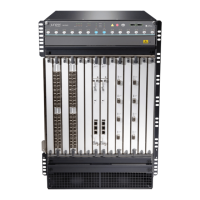Several types of DPCs are available. Each DPC includes either two or four Packet Forwarding Engines
(PFE). Each PFE enables a throughput of 10 Gbps.
Up to two PICs can be installed in each FPC. Fully populated, the MX960 supports up to 12 PICs.
Up to two Modular Interface Cards (MICs) can be installed in each MPC. Fully populated, the MX960
supports up to 24 MICs.
MPCs support fixed interfaces or up to two Modular Interface Cards (MICs) that can be installed in each
MPC. Fully populated, the MX960 supports up to 22 MICs.
For a list of the supported DPCs, FPCs, MPCs, MICs, PICs, and SCBs, see the MX Series Interface Module
Reference.
Table 4 on page 4 compares the switch fabric bandwidth capacities.
Table 4: Switch Control Board Capacities for MX Series 5G Universal Routing Platforms (Full-Duplex)
MX960 Fabric
Bandwidth
MX480 Fabric
Bandwidth
MX240 Fabric
BandwidthFabric Bandwidth Per SlotDescription
Up to 33 TbpsUp to 18 TbpsUp to 6 TbpsUp to 1.5 Tbps (non-redundant
fabric configuration with
MPC10E line cards); 1 Tbps
(redundant fabric configuration
with MPC10E line cards)
Enhanced MX Switch
Control Board (model
SCBE3-MX)
Up to 10.56 TbpsUp to 5.76 TbpsUp to 1.92 TbpsUp to 480 Gbps
(non-redundant fabric
configuration); 340 Gbps
(redundant fabric configuration)
Enhanced MX Switch
Control Board
(SCBE2-MX)
Up to 5.25 TbpsUp to 2.79 TbpsUp to 930 GbpsUp to 240 Gbps
(non-redundant fabric
configuration); 160 Gbps
(redundant fabric configuration)
Enhanced MX Switch
Control Board
(SCBE-MX)
Up to 2.6 TbpsUp to 1.39 TbpsUp to 465 GbpsUp to 240 Gbps
(non-redundant fabric
configuration); 120 Gbps
(redundant fabric configuration)
Switch Control Board
(SCB-MX)
The connections between interface cards and SCBs are organized in three groups:
•
Switch fabric—Connects the interface cards and provides for packet transport between DPCs, FPCs,
and MPCs. Two SCBs provide one non-redundant fabric. Three SCBs are required for a redundant fabric
configuration.
4

